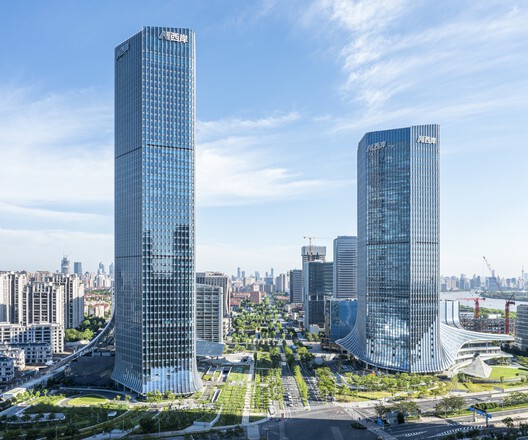This project, featuring a pair of skyscrapers, is located on the western bank of the Huangpu River (West Bund) in Shanghai. The renowned architectural firm Nikken Sekkei won the international design competition in 2009 to spearhead the transformation of the former Longhua Airport site into a modern metropolitan development. Over the past decade, the company has been actively engaged in both industrial and architectural design within the vicinity. The key distinguishing features of this project are its unique “wind style” concept and the distinctive volume shapes incorporated into the design. The influence of wind dynamics is evident in the structural design, exterior aesthetics, public spaces within the industrial zones, greenery, and interior spaces, forming the foundational principle of the entire endeavor.
The buildings sprawl across the landscape in a harmonious manner, resembling the graceful spread of a pair of wings, providing ample space for relaxation and leisure activities. The historical significance of the site as a former airport, the legacy of the local aerospace industry, and the prevailing wind patterns all play a pivotal role in inspiring the wind-oriented architectural approach adopted for the development. Advanced modeling techniques were employed early in the design phase to simulate airflow patterns and optimize the layout of the towers for human comfort. The aerodynamic structures not only enhance natural ventilation but also mitigate the downdraft effect typical of tall buildings, thereby reducing their environmental impact. To address the issue of heat island effect resulting from rapid urbanization, the design directs airflow towards the industrial areas behind the towers, promoting a more sustainable urban environment.
The expansive space stretching from north to south, once a runway, has been transformed into a verdant park teeming with lush vegetation, breathing new life into the urban landscape. The layout of the city inherits the spatial characteristics of the former airport, resembling a distinctive “plane” shape. Central to the project are two channels serving as pivotal connectors linking various transportation nodes, with a metro line running parallel to the playground area. An underwater passageway interlinks the buildings situated amidst the park, facilitating seamless pedestrian movement and connectivity to the train station and underground shopping precinct.
Embracing a philosophy of architectural harmony with nature, the project maximizes the natural assets of the location, leveraging the abundant water bodies and greenery. The eco-friendly design ethos harnesses the intrinsic “power of place,” offering occupants in the office and hotel spaces unparalleled views of the Huangpu River. The architectural elements, such as vertical fins on the facades, not only enhance the visual appeal but also optimize natural light and ventilation within the interiors. Energy-efficient technologies and sustainable practices are seamlessly integrated throughout the development, ensuring minimal energy wastage and environmental impact.
The integration of landscape elements with architectural design creates a seamless blend that accentuates the towers’ connection to the site, unlocking the full potential of the scenic surroundings. This distinctive approach, unique to the locale, has transformed the West Bund area into a vibrant hub for innovation and modernization, attracting cutting-edge industries like AI while paying homage to the region’s aviation heritage. The newly established five-star hotel, operational since March 2023, along with the retail and office spaces launched in 2021, signifies the dawn of a new era in industrial and architectural evolution within the West Bund precinct. These contemporary structures stand as a testament to the region’s rich history and aspirations for future growth, beckoning visitors to experience its transformative allure.
By: Eiichi Kano






